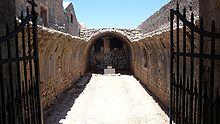Arkadi Monastery
The Arkadi Monastery ( Greek Μονή Αρκαδίου ) is a former Orthodox monastery on Crete . It existed from the 14th century to 1866 and is the island's most important national monument. The monastery played a prominent role in the Cretan struggle for independence from the Ottoman Empire . Until the introduction of the euro , the monastery church was depicted on the 100 drachma note.
location
The monastery is located in the regional district of Rethymno about 25 km south of the city of Rethymno in western Crete at an altitude of 500 meters above sea level on the foothills of the Psiloritis massif .
history
According to tradition, the Arkadi Monastery was built by the Byzantine Emperor Arcadius in the 5th century. Scientists, however, assume that it was founded by a monk of the same name. The name of the monastery is attested by an inscription for at least the 14th century. The two-nave , Renaissance elements having Basilica was in 1587 at the time of Venetian built domination of Crete and is the reconstruction of an earlier church. The monastery experienced its spiritual and cultural heyday until the 17th century.
After Crete had been completely conquered by the Ottoman Empire in 1669, the ringing of bells was forbidden in all churches and monasteries and the monastery was plundered. However, after having persuaded the pasha with gifts, the monks obtained permission to return to Arkadi and the right to ring the bell again. The monastery was renewed and the destroyed enclosure rebuilt.

After a part of today's Greek territory was granted independence from the Ottoman Empire in 1830, resistance to the Ottoman rule, perceived as an occupation, increased in Crete. In 1866, a revolutionary committee was formed in Arkadi Monastery. The abbot of Arkadi, Gabriel Marinakis (* approx. 1826), from the nearby Margarites , was elected chairman of the committee responsible for the Rethymno region . In Arkadi in September 1866, General Panos Koronaios (* 1809) sent from mainland Greece was appointed military commander of the uprising in the Rethymno region. Koronaios judged the monastery not to be defended, but could not prevail against the majority of the Revolutionary Committee with this view. The general then left the monastery with his men, but left a lieutenant behind as military leader.
On the night of November 7th to 8th, 1866, an Ottoman army with 15,000 men attacked the monastery, where 964 people, including 325 men fit for battle, were staying. After two days of hopeless resistance, the besieged decided not to fall into the hands of the enemy alive. When the battle had shifted to the monastery courtyard on November 9, most of those still alive, including women and children, withdrew to the powder magazine that was blown up by one of the fighters. In the violent explosion, all but a surviving girl were killed and dozens of Turkish soldiers intruded. 114 defenders were captured. 1500 attackers are said to have died during the siege of the Arkadi monastery. The abbot probably died in the final stages of the fight. The tradition, often implemented in the form of illustrations, that he himself ignited the powder magazine, is probably incorrect.
The circumstances surrounding the fall of the monastery attracted international attention. Among other things, Victor Hugo and Giuseppe Garibaldi assured the Cretans of their solidarity. However, in 1866 other events were on the agenda in Europe. It was not until 1897 that Crete became de facto independent, and in 1913 it was united with Greece.
In 1937 a stone slab with an inscription to commemorate the events of 1866 was placed in the east wall of the monastery. Today the plate is placed in the partially rebuilt powder magazine.
"This flame that was kindled in this crypt and lit glorious Crete from end to end was a flame of God in which the Cretans burned for freedom."
literature
- Stella Kalogeraki: Arkadi - The historical monastery. Mediterraneo Editions, Rethymno 2002, ISBN 960-8227-18-6 .
- Theocharis Provatakis: The Arkadi Monastery, History - Art - Traditions. Michalis Toubis, Athens 1986.
Web links
- Travel report and historical information. 2016, accessed May 2, 2016 .
Coordinates: 35 ° 18 ′ 37 ″ N , 24 ° 37 ′ 45 ″ E





